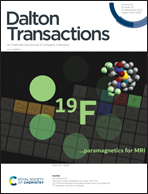Luminescent iridium(iii) porphyrin complexes as near-infrared-emissive biological probes†
Abstract
We report herein the design, synthesis and characterisation of a series of luminescent iridium(III) porphyrin complexes [Ir(ttp)(CH2CH2OH)] (H2ttp = 5,10,15,20-tetra-4-tolylporphyrin) (1), [Ir(tpp-Ph-NO2)(CO)Cl] (H2tpp-Ph-NO2 = 5-(4-((4-nitrophenoxy)carbonyloxymethyl)phenyl)-10,15,20-triphenylporphyrin) (2), [Ir(tpp-COOMe)(Py)2](Cl) (H2tpp-COOMe = 5-(4-methoxycarbonylphenyl)-10,15,20-triphenylporphyrin; Py = pyridine) (3) and [Ir(tpp-COOH)(Py)2](Cl) (H2tpp-COOH = 5-(4-carboxylphenyl)-10,15,20-triphenylporphyrin) (4). All the complexes displayed long-lived near-infrared (NIR) emission attributed to an excited state of mixed triplet intraligand (3IL) (π → π*) (porphyrin) and triplet metal-to-ligand charge transfer (3MLCT) (dπ(Ir) → π*(porphyrin)) character. The cytotoxicity of the complexes toward HeLa cells was examined by the 3-(4,5-dimethyl-2-thiazolyl)-2,5-diphenyltetrazolium bromide (MTT) assay. The cationic complexes 3 and 4 exhibited higher cytotoxic activity toward HeLa cells than their neutral counterparts 1 and 2. Cellular uptake studies by inductively coupled plasma-mass spectrometry (ICP-MS) and laser-scanning confocal microscopy (LSCM) indicated that complexes 3 and 4 showed higher cellular uptake efficiencies than complexes 1 and 2 due to their cationic charge, and they were enriched in the perinuclear region of the cells with negligible nuclear uptake. Additionally, the carboxyl complex 4 was used to label a model protein bovine serum albumin (BSA) via an amidation reaction. The resultant luminescent protein conjugate 4-BSA displayed similar photophysical properties and intracellular localisation behaviour to its parent complex. The results of this work will contribute to the development of luminescent iridium(III) porphyrin complexes and related bioconjugates as NIR-emissive probes for bioimaging applications.



 Please wait while we load your content...
Please wait while we load your content...